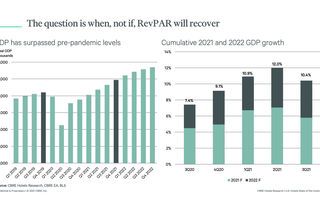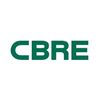CBRE Expects Lodging Revenue Per Available Room Recovery by Mid-2023

Average daily rate (ADR) gains and a 35.1% year-over-year increase in hotel occupancy in Q3 showed demand for U.S. hotel stays endured in the face of the Delta variant. Continued improvement in domestic travel and the rollback of many international travel restrictions have led CBRE to revise its forecast significantly upward in the near- and medium-term. Revenue per available room (RevPAR) is now forecast to reach 2019 nominal levels by the second half of 2023, rather than in 2024, as previously forecasted.
Still, the identification of the Omicron variant and ongoing concerns about the pandemic continue to dampen business, convention and large-group travel. CBRE expects these categories of travel to accelerate in the latter half of 2022, starting in lower-cost, high-amenity markets. Denser, high-cost-to-operate urban markets dependent on international or large-group travel will likely recover more slowly.
The continuing development of the Omicron variant as well as the potential for additional novel variants causes the uncertainty surrounding any forecast to remain elevated. While the hotel sector could face renewed travel restrictions, we expect higher occupancy levels from an increase in inbound international and business travel in 2022.
Room rate will lead the hotel recovery. According to CBRE Hotels Research’s December 2021 edition of Hotel Horizons®, ADR reached 2019 nominal levels in Q3, and CBRE expects ADR will continue to exceed 2019 levels, followed by a demand recovery in early 2023. Pent-up demand for leisure destinations, an increase in household personal savings and fewer constraints on availability compared with earlier in the pandemic contributed to the brisk pace of ADR recovery. The resumption of inbound international travel will help gateway markets regain occupancy in the coming year.
Moving forward, existing hotels will benefit from below-average new construction deliveries, as the cost and availability of construction inputs, including labor, will restrict supply growth to 1.2% to1.3% through 2025. This is well below the long-run average of more than 2%.
“Typically, when recovering from downturns, ADR growth lags occupancy gains,” said Rachael Rothman, CBRE’s Head of Hotel Research & Data Analytics. “The trend has reversed this cycle, owing to strong leisure demand and a nascent recovery in corporate and group demand.”
Revenue management focusing on rate rather than occupancy, as well as continued staffing difficulties, may prevent occupancy from reaching the highs of the last cycle; however, an ADR-led rebound contributes to faster recovery of profits.
The December 2021 edition of Hotel Horizons® for the U.S. lodging industry,65 major markets, the six hotel chain scales and six location types can be purchased by visiting: https://pip.cbrehotels.com.
About CBRE Group, Inc.
CBRE Group, Inc. (NYSE:CBRE), a Fortune 500 and S&P 500 company headquartered in Dallas, is the world's largest commercial real estate services and investment firm (based on 2023 revenue). The company has more than 130,000 employees (including Turner & Townsend employees) serving clients in more than 100 countries. CBRE serves a diverse range of clients with an integrated suite of services, including facilities, transaction and project management; property management; investment management; appraisal and valuation; property leasing; strategic consulting; property sales; mortgage services and development services. Please visit our website at www.cbre.com.
